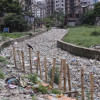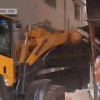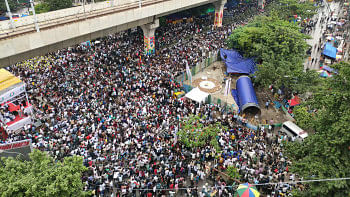Buildings outside Dhaka risky too

Some recent fire tragedies in the capital, including the one that left 26 people dead in Banani on March 28, once again exposed an abysmal fire safety in the city.
They also sparked calls for immediate and strict actions from the Rajdhani Unnayan Kartripakkha (Rajuk), the city's development authority, to prevent recurrence of such incidents.
But at the same time, fire safety in buildings in other major cities remains largely ignored.
A significant number of the buildings in the eight divisional headquarters across the country don't have fire safety preparations and thus remain vulnerable, said experts and officials concerned.
A fire department survey found one in every five houses in the eight city corporation areas to be highly risky. The 2017 survey also found that 90 percent buildings lacked fire safety arrangements.
Observing that fire incidents were more common in urban areas than in the rural side, the survey report said over 1,200 houses out of about 5,260 did not have basic fire safety precautions, including spacious approach road, water reservoir, fire extinguishers, fire escape and evacuation plans.
A total of 3,554 or 67.5 percent of the buildings were moderately risky, which meant that they had one or two of the fire safety arrangements mentioned above.
Only 10 percent of the buildings had satisfactory arrangements to tackle fire accidents, the report said.
Contacted, Brig Gen (retd) Abu Nayeem Md Shahidullah, former director general of Bangladesh Fire Service and Civil Defence, said, “Whenever there is a fire incident, the victims are the first responders. They should know what to do right away.
“It's clear from the study that 90 percent of the people in Bangladesh are not trained to do much in case of a fire.”
SITUATION IN DIVISIONAL CITIES
The bodies tasked with overseeing the matter -- either city corporations or city development authorities -- face manpower crisis in overseeing fire safety.
In Rajshahi city, there are around 18,000 buildings, including 163 high rises, approved by the Rajshahi Development Authority.
But both the city corporation and the city development authority lack the capacity to examine fire safety in those buildings, said officials from the authorities.
“Before approving plans for high rises, Rajshahi Development Authority requires checking whether the buildings have approval from the fire department,” said RDA's Authorised Officer Abul Kalam Azad.
“But once the buildings are constructed, the RDA can't go and see for itself whether the plans from the department have been implemented,” he said.
The RDA requires 30 to 50 employees to oversee the matter but it has only three, said its sources.
According to the Rajshahi City Corporation, the city has around 60,000 households with no fire safety at all.
Around 97 percent high-rise buildings in Chattogram city lack adequate fire safety measures, posing a serious risk of casualties in case of fire, according to a survey conducted by the Fire Service and Civil Defence.
The 2018 survey further revealed that 93 percent high rises did not even take “no objection certificates” from the fire service, said its officials.
In Sylhet city, there are around 54,000 holdings and around 200-250 buildings have more than six floors, according to the city corporation.
Nur Azizur Rahman, chief engineer of Sylhet City Corporation, said fire safety measures are absent in most of the high rises and that the fire department should regularly monitor the issue.
There are around 71,000 houses in Khulna City Corporation areas. Among them, 49 are high rises, said Md Wahiduzzaman Khan, revenue officer of KCC.
Every year, around 1,200 to 1,400 building plans are approved by the Khulna Development Authority, said Shamim Zihad, authorized officer of KDA.
“We do not look after the fire safety issue. It is taken care of by the Fire and Civil Defence,” he said.
In 2017, 45 people were killed in 18,105 fire incidents across the country. The incidents caused a loss of nearly Tk 257 crore. Last year, at least 130 people died in 19,642 fire incidents; the monetary loss was Tk 385 crore.
In the first three months of this year, fire has already claimed at least 96 lives in the capital -- 71 in Chawkbazar and 26 in Banani.
Talking on the safety, experts said any building has to maintain three kinds of safety measures -- structural, electrical and fire protection.
On average, Tk 1.5 crore is needed to ensure fire safety at a high rise. Besides, regular maintenance requires a good amount of money.
“Because of this, building owners and developers tend to ignore the extremely crucial issue,” said Brig Gen (retd) Shahidullah.
He also said owners often get approval for their buildings by showing the authorities the plans given by the fire department.
“It takes three to five years to erect a high rise and the fire department does not have the resources to check whether the building implemented the plans. The owners take advantage of this,” he said.
He suggested that the government makes it mandatory for buildings to ensure fire safety for getting utility connections.
Talking to The Daily Star, Brig Gen (retd) Ali Ahmed Khan, the immediate past director general of the fire service, said making schools and colleges ready to fight fire does not require huge investments.
“Wide staircases, fire escape routes, extinguishers, water reservoirs and installing some basic equipment are good enough,” he said.
Ali also said that government and individual initiatives in this regard should be the first and foremost priority now.

 For all latest news, follow The Daily Star's Google News channel.
For all latest news, follow The Daily Star's Google News channel. 








Comments